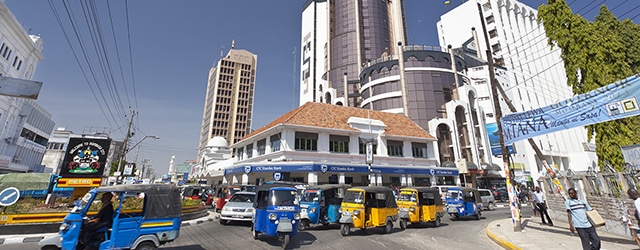Some African nations may face a debt crisis if their economic growth stagnates.
 Mombasa City, Kenya |
In sub-Saharan Africa, too-high debt has become the hornets’ nest poised ominously next door to the fruit of economic growth. After years of stellar performance, economic growth is slowing down. The World Bank projects GDP to expand by only 2.6% this year, a mere 0.1% improvement over 2018.
Many factors have contributed the region’s growth slowdown, but the excess debt is emerging as a major risk. Over the past six years, the number of countries in debt distress or at high risk of distress has almost doubled.
“Debt in sub-Saharan Africa is accelerating, and this is a worrying trend,” says Peter Chacha, senior economist in the World Bank’s Macroeconomics, Trade and Investment Unit.
Angola, Cabo Verde, Mozambique, Zimbabwe, Sudan, Gambia, São Tomé and Principe, Somalia and the Republic of Congo all have crossed the line into debt distress, meaning that debt to GDP is above 80%. For Cabo Verde, Mozambique and Sudan, it has surpassed 100%, which for fragile emerging economies can spell the end of a fragile emerging economy’s ability to borrow commercially.
Another group of countries, including Zambia, Ghana, Cameroon, Ethiopia, Djibouti, Mauritania and Sierra Leone, are also causing apprehension. While some of these have seen strong growth, the World Bank classifies their debt distress level as “high.” Zambia’s debt load stood at $18.3 billion at the end of 2018, accounting for 78.1% of GDP. Ethiopia faces a $52 billion burden, prompting it to ask China, a major lender, to restructure some of its loans.
“For these countries, planned fiscal consolidation must stick to a path that seeks to reduce debt,” Chacha advises. Even more worrying, countries with relatively strong economies, including Kenya, Cote d’Ivoire and Burkina Faso, have entered the bank’s “moderate” zone due to stepped-up government borrowing.
As the region’s economies slow, a higher proportion of dwindling revenues are being directed to debt service, leaving fewer resources for development. In some countries, external debt service exceeds 50% of revenue. And with interest rates edging upward, currencies are feeling the pressure while reserves are shrinking.



